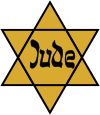The International Jew
The International Jew is a four-volume set of antisemitic booklets or pamphlets originally published and distributed in the early 1920s by the Dearborn Publishing Company, which was owned by Henry Ford, the American industrialist and automobile manufacturer.
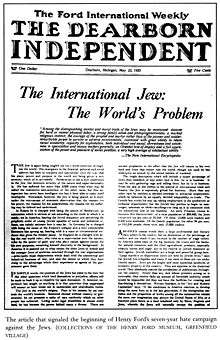
| The Protocols |
|---|
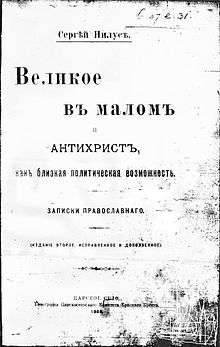 |
| First publication of The Protocols |
| Writers, editors, and publishers associated with The Protocols |
| Debunkers of The Protocols |
| Commentaries on The Protocols |
|
The books are to be distinguished from The International Jew: The World's Problem which was a headline in The Dearborn Independent, and is also the name of a collection of articles serialized in The Dearborn Independent.
Background
At the beginning of 1920, Ford's personal newspaper, The Dearborn Independent, was languishing in subscriptions and losing money. Ford and his personal secretary, Ernest G. Liebold, began to discuss a series of articles on "The Jewish Question."[1]:97 While it was Liebold who claimed to have come up with the title, The International Jew, he turned to "the walking dictionary" William J. Cameron, for most of the writing.[1]:99,103 For 91 issues, the weekly paper announced a variety of Jewish-evil-influenced major stories in its headlines.
Editor E. G. Pipp left the Independent in April 1920 in disgust with the planned antisemitic articles, which began in May. Ford did not write the articles. He expressed his opinions verbally to Liebold, and to Cameron, who replaced Pipp as editor. Cameron had the main responsibility for expanding these opinions into article form. Liebold was responsible for collecting more material to support the articles.[1]:98-100
The most popular and aggressive stories were then chosen to be reprinted into four volumes called The International Jew.[2] The first volume was published in November 1920 as an anthology of articles that had been published in the Independent from May 22 to October 2, 1920. The original print run of the first edition was estimated to be between 200,000 and 500,000 copies. Three additional volumes were published over the next 18 months.[1]:145
Liebold never copyrighted The International Jew and therefore had no control over anyone else publishing it themselves. The book was ultimately translated into 16 languages, including six editions in Germany between 1920 and 1922, and has remained in the public domain.[1]:145
Content
After publication in the periodical, the articles were compiled into a four volume set as follows:[3]
Volume 1: The International Jew: The World's Foremost Problem (1920)
Chapters
- The Jew in Character and Business
- Germany's Reaction Against the Jew
- Jewish History in the United States
- The Jewish Question—Fact or Fancy?
- Anti-Semitism—Will It Appear in the U.S.?
- Jewish Question Breaks Into the Magazines
- Arthur Brisbane Leaps to the Help of Jewry
- Does a Definite Jewish World Program Exist?
- The Historic Basis of Jewish Imperialism
- An Introduction to the "Jewish Protocols"
- "Jewish" Estimate of Gentile Human Nature
- "Jewish Protocols" Claim Partial Fulfillment
- "Jewish" Plan to Split Society by "Ideas"
- Did the Jews Foresee the World War?
- Is the Jewish "Kahal" the Modern "Soviet"?
- How the "Jewish Question" Touches the Farm
- Does Jewish Power Control the World Press?
- Does This Explain Jewish Political Power?
- The All-Jewish Mark on "Red Russia"
- Jewish Testimony in Favor of Bolshevism
Volume 2: Jewish Activities in the United States (1921)
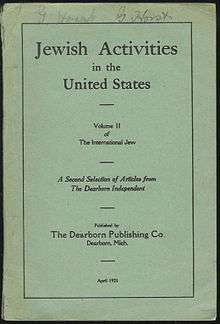
Chapters
- How Jews in the U.S. Conceal Their Strength
- Jewish Testimony on "Are Jews a Nation?"
- Jew Versus Non-Jew in New York Finance
- The High and Low of Jewish Money Power
- "Disraeli of America"—A Jew of Super-Power
- The Scope of Jewish Dictatorship in the U.S.
- Jewish Copper Kings Reap Rich War-Profits
- Jewish Control of the American Theater
- The Rise of the First Jewish Theatrical Trust
- How Jews Capitalized a Protest Against Jews
- The Jewish Aspect of the "Movie" Problem
- Jewish Supremacy in Motion Picture World
- Rule of the Jewish Kehillah Grips New York
- The Jewish Demand for "Rights" in America
- "Jewish Rights" Clash With American Rights
- "Jewish Rights" to Put Studies Out of Schools
- Disraeli—British Premier, Portrays the Jews
- Taft Once Tried to Resist Jews—and Failed
- When Editors Were Independent of the Jews
- Why the Jews Dislike the Morgenthau Report
- Jews Use the Peace Conference to Bind Poland
- The Present Status of the Jewish Question
Volume 3: Jewish Influence in American Life (1921)
Chapters
- The Jews and the "Religious Persecution" Cry
- Are the Jews Victims or Persecutors?
- Jewish Gamblers Corrupt American Baseball
- Jewish Degradation of American Baseball
- Jewish Jazz Becomes Our National Music
- How the Jewish Song Trust Makes You Sing
- Jewish Hot-Beds of Bolshevism in the U.S.
- Jew Trades Link With World Revolutionaries
- Will Jewish Zionism Bring Armageddon?
- How the Jews Use Power—By an Eyewitness
- How Jews Ruled and Ruined Tammany Hall
- Jew Wires Direct Tammany's Gentile Puppets
- B'nai B'rith Leader Discusses the Jews
- Dr. Levy, a Jew, Admits His People's Error
- Jewish Idea in American Monetary Affairs
- Jewish Idea Molded Federal Reserve Plan
- Jewish Idea of Central Bank for America
- How Jewish International Finance Functions
- Jewish Power and America's Money Famine
Volume 4: Aspects of Jewish Power in the United States (1922)
Chapters
- How Jews Gained American Liquor Control
- Gigantic Jewish Liquor Trust and Its Career
- The Jewish Element in Bootlegging Evil
- Angles of Jewish Influence in American Life
- The Jews' Complaint Against "Americanism"
- The Jewish Associates of Benedict Arnold
- Benedict Arnold and Jewish Aid in Shady Deal
- Arnold and His Jewish Aids at West Point
- The Gentle Art of Changing Jewish Names
- Jewish "Kol Nidre" and "Eli, Eli" Explained
- Jews as New York Magistrates See Them
- Jews Are Silent, the National Voice Is Heard
- What Jews Attempted When they Had Power
- The Jewish Question in Current Testimony
- America's Jewish Enigma—Louis Marshall
- The Economic Plans of International Jews
- A Jew Sees His People As Others See Them
- Candid Address to Jews on the Jewish Problem
- An Address to "Gentiles" on the Jewish Problem
1927 libel suit
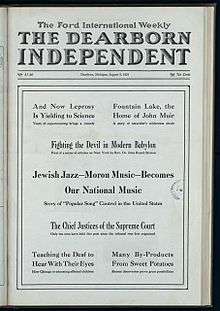
A libel lawsuit, brought by San Francisco lawyer and Jewish farm cooperative organizer Aaron Sapiro in response to antisemitic remarks, led Ford to close the Independent in December 1927. News reports at the time quoted him as being shocked by the content and having been unaware of its nature.
During the trial, William J. Cameron, the editor of Ford's "Own Page", testified that Ford had nothing to do with the editorials even though they were under his byline. Cameron testified at the libel trial that he never discussed the content of the pages nor sent them to Ford for his approval.[4] Investigative journalist Max Wallace doubted the veracity of this claim and wrote that James M. Miller, a former Dearborn Independent employee, swore under oath that Ford had told him he intended to expose Sapiro.[5]
According to Michael Barkun, "That Cameron would have continued to publish such controversial material without Ford's explicit instructions seemed unthinkable to those who knew both men. Mrs. Stanley Ruddiman, a Ford family intimate, remarked that 'I don't think Mr. Cameron ever wrote anything for publication without Mr. Ford's approval.'"[6]
Influence on Nazi anti-Semitism
Ford's International Jew was translated into German in 1922 and cited as an influence by Baldur von Schirach, one of the Nazi leaders, who stated "I read it and became anti-Semitic. In those days this book made such a deep impression on my friends and myself because we saw in Henry Ford the representative of success, also the exponent of a progressive social policy. In the poverty-stricken and wretched Germany of the time, youth looked toward America, and apart from the great benefactor, Herbert Hoover, it was Henry Ford who to us represented America."[7] Ford is the only American mentioned in Hitler's Mein Kampf, but he is only mentioned once in one sentence, where Hitler writes "Every year makes them [American Jews] more and more the controlling masters of the producers in a nation of one hundred and twenty millions; only a single great man, Ford, to their fury still maintains full independence." The second edition of the book removed reference to Ford.[8]
George F. Green and the Christian Nationalist Crusade
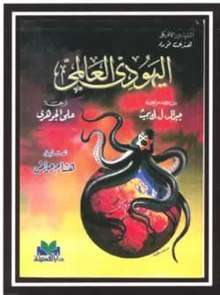
In June 1949, a 174-page, one-volume abridgement of the text appeared, titled The International Jew, subtitled "The World's Foremost Problem", edited by the British journalist and fascist George F. Green[10] who served as the editor of the Independent Nationalist.[11] The book was sold in the United States by the Christian Nationalist Crusade.[12][13]
See also
- The Eternal Jew
- Zionist Occupation Government
- Protocols of Zion (film)
- New World Order (conspiracy theory)
- Psychological warfare
References
- Neil Baldwin (2001). Henry Ford and the Jews: Mass Production of Hate. PublicAffairs.
- Albert Lee (1980). Henry Ford and the Jews. Stein and Day. p. 14.
- The International Jew. The World's Foremost Problem. Being a Reprint of a Series of Articles Appearing in The Dearborn Independent from May 22 ... 1920 [to January 14, 1922] Dearborn, Mich. Dearborn Publishing Co., 1920-1922
- Lewis, (1976) pp. 140-156; Baldwin p 220-221.
- The American Axis: Henry Ford, Charles Lindbergh, and the Rise of the Third Reich by Max Wallace, p. 30.
- Barkun, Michael (1996). Religion and the Racist Right: The Origins of the Christian Identity Movement. UNC Press. ISBN 0-8078-4638-4, p. 35.
- Nuremberg Trial Proceedings. 14. Avalon Project. 23 May 1946. p. 368. Retrieved 2016-05-25.
- Hitler, Adolf. My Struggle. Houghton Mifflin. p. 639.
- The International Jew Arabic edition. Publisher: Dar al-Fadhilah, Cairo, Egypt. Translator: Ali al-Gawhari. The International Jew: a commercial success in Egypt Archived 2011-11-23 at the Wayback Machine
- Carlson, John Roy (1951). Cairo to Damascus. Knopf. p. 37.. This George F. Green seems not to be the same person G. F. Green (George Frederick Green), a British fiction writer.
- Macklin, Graham (2007). Very Deeply Dyed in Back: Sir Oswald Mosley and the Resurrection of British Fascism After 1945. London: I.B. Taurus. p. 106. ISBN 978-1-84511-284-4.. This Independent Nationalist is not the same as the Irish political title "Independent Nationalist".
- Bernard Glassman (2003). Benjamin Disraeli: The Fabricated Jew in Myth and Memory. University Press of America. p. 189. ISBN 978-0-7618-2540-1.
- Elof Axel Carlson (2001). The Unfit: A History of a Bad Idea. CSHL Press. p. 312. ISBN 978-0-87969-587-3.
Secondary sources
- Ford R. Bryan, Henry's Lieutenants (Detroit: Wayne State University Press, 1993) ISBN 0-8143-2428-2 (paper)
- Albert Lee, Henry Ford and the Jews (New York: Stein and Day, 1980) ISBN 0-8128-2701-5
- Max Wallace, The American Axis: Henry Ford, Charles Lindbergh, and the Rise of the Third Reich (New York: St. Martin's Press, 2003) ISBN 0-312-29022-5
- Neil Baldwin, Henry Ford and the Jews: The Mass Production of Hate (PublicAffairs, 2000); ISBN 1-58648-163-0
External links
| Wikisource has original text related to this article: |
- The New York Public Library, Catalog Record
- Statement by Henry Ford pamphlet issued by American Jewish Committee
- The International Jew - The World's Foremost Problem – complete four volumes at The Internet Archive
